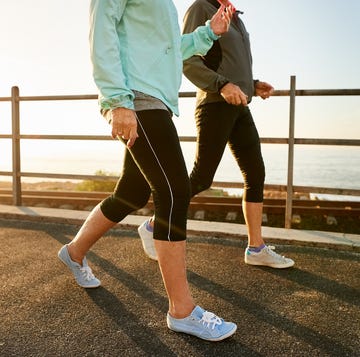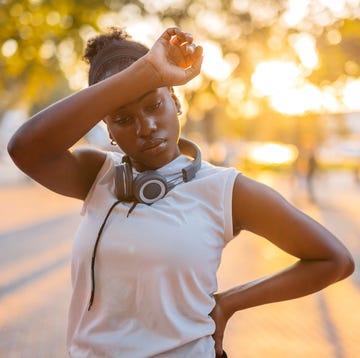The stats are pretty alarming: muscle mass declines 3-8% per decade after age 30, and the rate of loss accelerates even more after age 60. The good news? It's never too late to start moving, and resistance training in particular has been shown to increase muscle mass, improve bone density and boost metabolic health in postmenopausal women.
As a NASM-certified personal trainer, I've seen firsthand the power of pushups for women of all ages, but especially for those over 50. And before you think, "There's no way I can do a pushup," hear me out: you absolutely can, and you absolutely should.
Pushups are a foundational movement that delivers not just strength, but also confidence, independence and longevity. Ahead, I'll break down why pushups are so essential as we age, with insights from an exercise physiologist and menopause-focused OB-GYN, and provide easy modifications if you're brand new to pushups but want to get started.
Why pushups matter after 50
"Strength and resistance training is imperative for women over 50," says board-certified OB-GYN Dr. Jessica Shepherd, who serves as a Medical Advisory Board Member for the nonprofit organization Let's Talk Menopause. "This is when there is a significant shift in hormones that also impact muscle mass."
Sarcopenia, or age-related muscle loss, is real and resistance training is one of the most effective ways to build strength, support bone density and prevent osteoporosis. "When muscles contract, they pull on the bones," Dr. Shepherd explains. "That stress, whether from body weight or free weights, will cause stimulation and the creation of calcium deposits, and that starts the process of bone formation."
While there are many different types of strength training exercises, mastering your own bodyweight through a pushup is particularly valuable. It not only builds upper body strength, but also core stability, posture and endurance. "I always emphasize pushups in my practice," Dr. Shepherd says. "They're simple, effective, and can be done anywhere."
As a personal trainer, I know how beneficial yet challenging pushups can be, and that's exactly why they're so powerful. To perform one well, you need strength in nearly every major muscle group, which is a true full-body test of function.
Applied exercise physiologist and research scientist at Orangetheory Fitness Dr. Brittany Leboeuf, PhD agrees. "Pushups are one of the most functional and accessible strength exercises available. For women over 50, they’re particularly valuable because they engage multiple muscle groups at once while requiring no equipment."
She adds that pushups are a smart way to counter age-related declines in muscle mass, upper body strength and core stability, key pillars of independence and injury prevention as we age.
But specifically for women over 50, Dr. Leboeuf says that pushups target areas that tend to weaken as women age, such as the chest, shoulders, triceps and core. "These muscles play an essential role in posture, balance and daily functional tasks like lifting, carrying and bracing yourself during a fall. They also contribute to joint protection and bone density, which becomes increasingly important in the post-menopausal years due to decreased estrogen levels."
Menopause and muscle
"In menopause, at the average age of 52, the change in hormones is a determinant in the loss of skeletal muscle mass," Dr. Shepherd explains. "Estrogen deficiency contributes to loss in muscle strength. In fact, of the millions of women worldwide who enter menopause, more than 70% will experience musculoskeletal symptoms and 25% will be disabled by them through the transition from perimenopause to postmenopause." During this life transition, she says that musculoskeletal changes seen include:
- Musculoskeletal pain
- Loss of lean muscle mass
- Arthralgias (joint pain)
- Loss of bone density
- Increases in tendon and ligament injuries
- Weakness and increased injuries overall
The good news, Dr. Shepherd says, is that resistance training is one of the most effective ways to counteract these changes. "Resistance training can challenge muscles in order to build strength, which improves function and helps prevent falls and injuries in the future.
She also emphasizes the importance of muscle power, or the ability to generate force quickly, which is essential for everyday activities like rising from a chair or catching yourself when you stumble. Improving strength and power not only supports physical function, but also helps improve longevity and quality of life.
What pushups do for your body
Pushups require no equipment, are accessible to most people, and offer a full-body compound movement you can do just about anywhere. According to Dr. Leboeuf, pushups primarily target the chest (pectorals), shoulders (deltoids), triceps and core, including the deep stabilizing muscles of the abdominals and lower back. "These are vital for maintaining upper body strength, improving spinal alignment and supporting overall mobility." There is also subtle engagement of the glutes and legs as stabilizers, which she says offers whole body integration in a single movement.
But most interestingly, Dr. Leboeuf notes that pushups train neuromuscular coordination, which is the communication between your brain, nerves and muscles. "As we age, maintaining this system is key for preserving balance, reaction time and fall prevention."
And despite their reputation, pushups are highly modifiable for all fitness levels. "The key is to meet your body where it is and progress with consistency," Dr. Leboeuf says. "No matter where someone starts, the goal is progression. With the right support and modifications, you can build the strength to master pushups over time."
How to do pushups the right way
Dr. Leboeuf walks through the key steps for performing a pushup with solid form.
Standard Pushup Form
- Start in a high plank position with your hands slightly wider than shoulder-width apart, fingers pointing forward. Your shoulders should stack directly above your wrists.
- Engage your core, squeeze your glutes and create a straight line from your head to your heels.
- Lower with control, keeping your elbows at about a 45-degree angle from your torso, not flaring out wide or tucking in too close.
- Stop when your chest is just above the floor, or as low as you can maintain good form.
- Press back up through your palms, keeping your body in a straight line.
Beginner-friendly modifications
Frequency and reps
For most women, Dr. Leboeuf recommends doing pushups two to three times per week as part of a well-rounded strength routine. This frequency allows for muscle adaptation and recovery, while building strength progressively, she says.
When it comes to reps, quality beats quantity. "Start with a manageable number of reps — even 5–10 solid pushups can be effective — and focus on progressing over time through reps, difficulty or tempo," Dr. Leboeuf says. "It's important to train to the point of challenge without sacrificing form."
Progression Plan
"A smart progression plan might start with incline pushups or negatives and gradually build toward full bodyweight reps," Dr. Leboeuf recommends. As you get stronger:
- Increase reps gradually
- Reduce the height of your incline
- Add tempo (i.e. 3-second lowering phase)
- Combine pushups with other strength moves in a superset
With consistency and the right approach, you’ll build the strength and control to master pushups at any stage of life.
The bottom line
Strength is ageless, and it's never too late to start resistance training. A functional, full-body movement, pushups recruit multiple muscle groups and require no equipment, making them both effective and accessible. Start with modifications, like wall or incline pushups, and focus on form as you build strength. With consistency, you can reclaim your power, restore your function and feel strong in your body, one pushup at a time.
Why trust Good Housekeeping?
- Stefani Sassos is a NASM-certified personal trainer, Women's Fitness Specialist and Behavior Change Specialist with over a decade of experience in the fitness industry. As the fitness director of the Good Housekeeping Institute, she tests exercise equipment and develops informed workout content to help readers lead healthier lives.
- Dr. Brittany Leboeuf, PhD, is an applied exercise physiologist and research scientist specializing in women’s health and the long-term impact of structured exercise. At Orangetheory Fitness, she leads research-driven program development to ensure every workout supports the evolving needs of its members across all life stages. Her expertise centers on the physiological effects of strength and cardiovascular training, with a focus on overall well-being. Through her work, she helps shape science-backed fitness experiences designed to enhance functional strength, improve health outcomes and empower women to move with confidence at any age.
- Dr. Jessica Shepherd, MD, MBA, FACOG, is a board-certified OB/GYN and a leading voice in women’s health and longevity. As a wife, mother, author, CEO, and media personality on her own perimenopause journey, she brings personal insight and professional expertise to her mission of empowering women through every stage of life. Dr. Shepherd’s influence reaches far beyond her practice. A sought-after voice in the media, she shares her insights as a regular on-air contributor on Good Morning America and has been featured on The Today Show, LIVE with Kelly and Mark, CNN, and Dr. Oz. She is also a Medical Advisory Board Member of the nonprofit organization Let's Talk Menopause.















